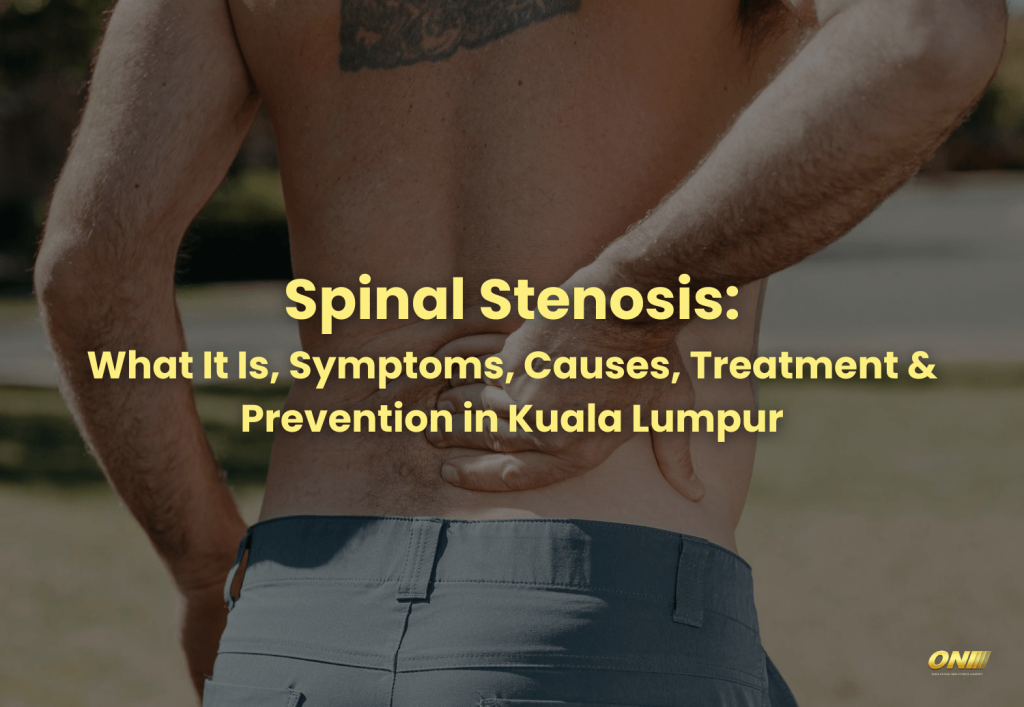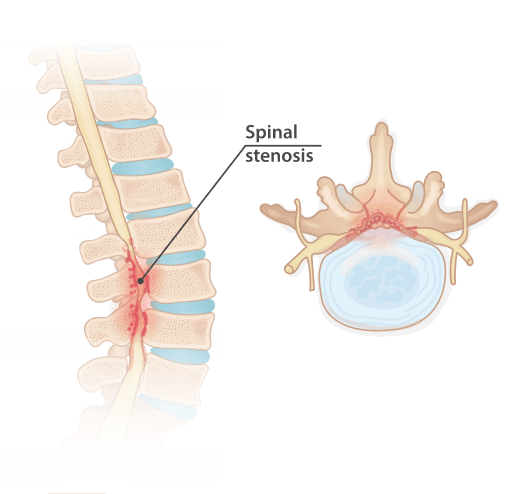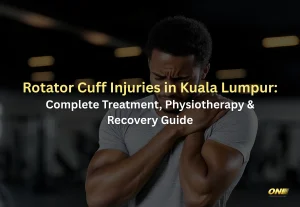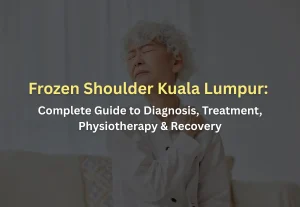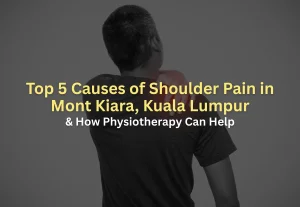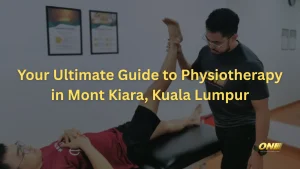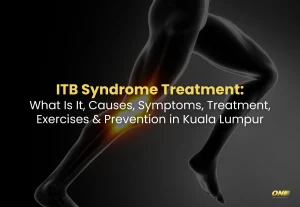Introduction
Spinal stenosis is a common condition that can cause significant discomfort and impact your quality of life.
If you are experiencing persistent back pain, it may be related to spinal stenosis. Understanding what spinal stenosis is, its symptoms, causes, and treatment options, especially in Kuala Lumpur, can help you take proactive steps toward managing this condition effectively.
Whether you live in Mont Kiara or anywhere else in Kuala Lumpur, knowing where to seek proper treatment, including physiotherapy, is essential for your well-being.
ONI Physio Fitness Spinal Stenosis Assessment
What Is Spinal Stenosis?
Spinal stenosis refers to the narrowing of the spaces within your spine, which can put pressure on the nerves that travel through the spine. This condition most commonly occurs in the lower back (lumbar spine) and the neck (cervical spine). As the spinal canal narrows, it can lead to symptoms such as pain, numbness, and weakness in the affected areas. The severity of spinal stenosis can vary, with some individuals experiencing mild discomfort, while others may suffer from debilitating pain.
Symptoms of Spinal Stenosis
The symptoms of spinal stenosis often develop gradually and worsen over time. Common symptoms include:
- Back Pain: Persistent or intermittent pain in the lower back is a hallmark of lumbar spinal stenosis. This pain can radiate to the buttocks, thighs, and legs.
- Numbness or Tingling: You may experience numbness, tingling, or a “pins and needles” sensation in the extremities, especially in the legs or arms.
- Weakness: Weakness in the legs or arms can occur, leading to difficulty walking or maintaining balance.
- Cramping: Some people with spinal stenosis experience cramping in the legs, especially after prolonged periods of standing or walking.
- Pain When Standing or Walking: This condition, known as neurogenic claudication, occurs when walking or standing for long periods aggravates the pain, while sitting or bending forward can relieve it.
Causes of Spinal Stenosis
Several factors can contribute to the development of spinal stenosis, including:
- Aging: The natural aging process can lead to wear and tear on the spine, causing changes such as thickening of ligaments, bone spurs, and herniated discs that narrow the spinal canal.
- Arthritis: Osteoarthritis and rheumatoid arthritis can result in the deterioration of spinal structures, leading to spinal stenosis.
- Herniated Discs: When a disc in the spine ruptures or bulges, it can compress the spinal cord or nerves, contributing to spinal stenosis.
- Injuries: Trauma or injuries to the spine, such as fractures, can result in spinal stenosis over time.
- Genetics: Some individuals are born with a naturally narrow spinal canal, making them more susceptible to spinal stenosis.
Spinal Stenosis Treatment
Treating spinal stenosis effectively often requires a multifaceted approach. At ONI Physio Fitness in Kuala Lumpur, we offer personalized treatment plans that focus on relieving pain, improving mobility, and enhancing your overall quality of life.
Physiotherapy is a cornerstone of spinal stenosis treatment. Our skilled physiotherapists in Mont Kiara work closely with you to develop a tailored exercise program that strengthens the muscles supporting your spine, improves flexibility, and reduces nerve compression. Through targeted exercises, manual therapy, and pain management techniques, we help alleviate symptoms and prevent further progression of the condition.
Exercises for Spinal Stenosis
Incorporating specific exercises into your routine can be highly beneficial in managing spinal stenosis. Here are three exercises that can help:
1. Pelvic Tilts:
- Lie on your back with your knees bent and feet flat on the floor.
- Tighten your abdominal muscles and gently flatten your lower back against the floor.
- Hold for 5 seconds, then relax.
- Repeat 10-15 times.
2. Knee-to-Chest Stretch:
- Lie on your back with your knees bent and feet flat on the floor.
- Bring one knee up towards your chest, holding it with both hands.
- Hold the stretch for 15-30 seconds.
- Switch legs and repeat 2-3 times on each side.
3. Cat-Cow Stretch:
- Start on your hands and knees in a tabletop position.
- Inhale as you arch your back, lifting your head and tailbone towards the ceiling (Cow Pose).
- Exhale as you round your back, tucking your chin towards your chest (Cat Pose).
- Repeat 10-15 times, moving slowly and mindfully.
Prevention for Spinal Stenosis
While spinal stenosis is often related to age and certain unavoidable conditions like arthritis, there are steps you can take to reduce your risk or slow its progression. By focusing on maintaining a healthy spine, you can help prevent spinal stenosis and related back pain. Here are some key strategies:
Use Proper Lifting Techniques: When lifting heavy objects, always use proper techniques to avoid putting excessive pressure on your spine. Bend your knees, keep the object close to your body, and lift with your legs, not your back. This approach helps prevent injuries that could lead to spinal stenosis.
Maintain a Healthy Weight: Excess weight can put additional stress on your spine, particularly on the lower back. By maintaining a healthy weight through a balanced diet and regular exercise, you can reduce the strain on your spine and lower your risk of developing spinal stenosis.
Stay Active: Regular physical activity is essential for spinal health. Engaging in exercises that strengthen the muscles supporting your spine, such as core exercises, can help maintain proper alignment and reduce the risk of stenosis. Low-impact activities like walking, swimming, and cycling are particularly beneficial.
Practice Good Posture: Maintaining proper posture throughout the day can help prevent spinal problems. Whether you’re sitting, standing, or lifting objects, be mindful of your posture to avoid putting unnecessary strain on your spine. Ergonomic adjustments in your workspace, such as using a supportive chair or adjusting your computer screen height, can also promote good posture.
Avoid Smoking: Smoking can accelerate the degeneration of spinal discs and decrease blood flow to the spine, increasing the risk of spinal stenosis. Quitting smoking or avoiding it altogether can help protect your spinal health and prevent the onset of stenosis.
Incorporate Flexibility and Strength Training: Flexibility exercises, such as yoga or stretching routines, can help maintain the mobility of your spine and reduce stiffness. Strength training, particularly exercises that target the back, core, and hip muscles, can support your spine and prevent the narrowing of the spinal canal.
Regular Check-ups: Regular check-ups with your healthcare provider can help detect early signs of spinal issues. If you experience any persistent back pain, numbness, or tingling in your limbs, seek medical advice promptly. Early intervention can prevent minor issues from developing into more severe conditions like spinal stenosis.
By incorporating these preventive measures into your daily routine, you can reduce the likelihood of developing spinal stenosis and maintain a healthy spine as you age. Prevention is always better than cure, so take proactive steps today to protect your spinal health.
Conclusion
If you are struggling with spinal stenosis or back pain in Kuala Lumpur, don’t wait for the pain to worsen. Visit ONI Physio Fitness in Mont Kiara for a thorough assessment and personalized treatment plan. Our expert physiotherapists are here to help you regain your mobility and live a pain-free life. Contact us today to schedule your appointment and take the first step toward recovery.

